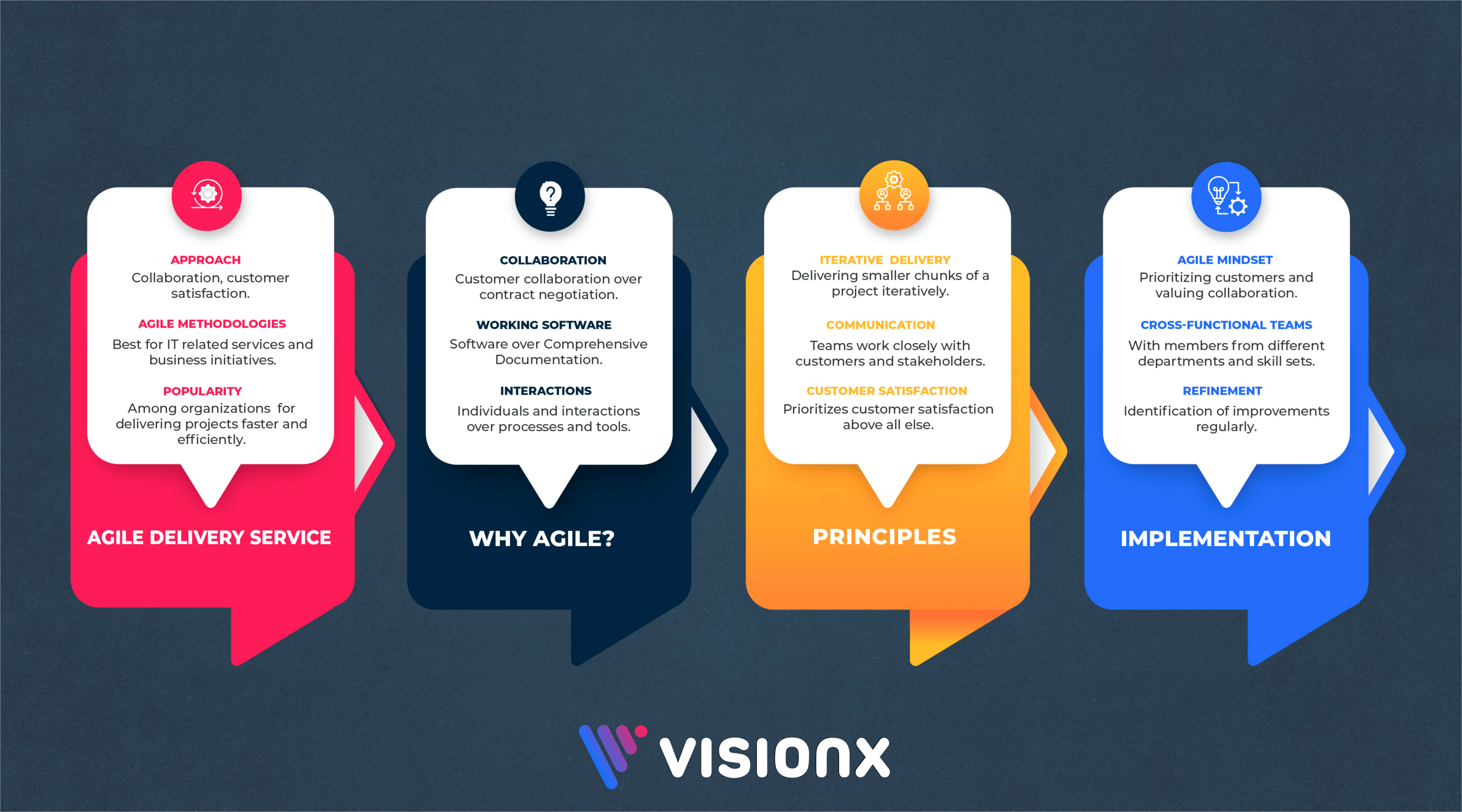Agile is a popular way to build software that focuses on collaboration, flexibility, and delivering value to customers. It works very differently from traditional “waterfall” development.
Agile breaks big projects into small pieces called “user stories.” Short iterations allow teams to adapt quickly. Transparency and feedback help create better products that make customers happy.

This article explains the key benefits of Agile methodology. Read on to see why Agile helps software teams be more productive and creative. We’ll also discuss how it benefits business needs overall. The main goals are faster time to market, reduced risk and costs, and more satisfied users.
8 Key Benefits of Agile Methodology
1. Collaboration Improves Communication
In Agile, cross-functional teams work closely together daily. This includes developers, testers, operations, managers, and business people. Together they focus on building working software in small batches.
Frequent communication replaces formal documentation. Whiteboards, sticky notes, and tools like Slack or Trello allow real-time sharing of information. This creates transparency on what everyone is doing.
Constant collaboration breaks down barriers between roles. Misunderstandings get cleared up faster. Teams solve problems collectively and learn from each other. Working software also provides clarity that long-written requirements can lack. Overall, enhanced communication leads to better project results.
2. Customer Focus Delivers Business Value
Agile teams focus on delivering tangible business value in each release. Working software gets delivered in weeks rather than months or years. This allows customers to provide feedback frequently. Products can be adapted based on real user data in weeks rather than guessing what users might want.
Each release goes through planning, development, testing, and deployment. Priorities come from the business side based on what creates the most value for customers. This ensures the development team builds features that customers want and will use. Releases continue iteratively allowing for refinement and resources to be adjusted appropriately.
The result is products that delight customers and meet real business needs. Value gets delivered faster so a positive impact on the business happens sooner.
3. Frequent Releases Reduce Risk
Delivering in small chunks rather than one major release at the end also reduces risk. Potential issues or changing requirements get identified much earlier when they are easier to fix.
If a 2-week iteration fails, only 2 weeks of work is lost. For long projects that take 6-12 months, changing course late can mean millions of dollars and months of wasted effort. Delayed or failed releases also delay the achievement of business goals tied to the software or update.
Additionally, each increment provides value so partial solutions can still be used if some features get cut. Customers also appreciate more frequent updates with new capabilities rather than waiting a year or more. This flexibility ensures the highest business value features make it into production for real user benefit.
4. Adapting to Change Drives Innovation
Agile is embracing change to drive innovation. Teams start projects knowing that requirements will evolve based on business and user feedback. Planning happens at both release and iteration levels to map out goals and tasks. However, the team is empowered to adjust based on new learnings or obstacles.
Being open to change, prevents teams from sticking rigidly to outdated plans when better ideas emerge. Developers can also suggest creative ways to meet goals based on hands-on work with the code. Customers see their feedback shape a product that solves real problems rather than imagined ones.
Built-in adaptability leads to innovation rather than following prescribed solutions. It also boosts morale by empowering teams to steer projects in positive directions within the guiding vision. Overall productivity and creativity increase dramatically.
5. Metrics Provide Visibility
Agile also emphasizes visibility, accountability, and objectivity through concrete metrics. Tracking cycle time shows how long tasks take to complete. Measuring output productivity demonstrates team velocity or work completed per iteration.
Tracking progress gives early warnings on roadblocks or capacity issues. Daily standups and retros allow teams to quickly address obstacles and improve processes. Rather than yearly performance reviews, Agile provides continuous feedback and coaching.
With defined metrics, anyone can objectively see if outcomes match targets set across business, technology, and process dimensions. This data removes subjective bias and arguments. When aligned with business value, metrics focus teams on achieving core goals over rigidly following arbitrary rules.
6. Automation Accelerates Delivery
Many Agile frameworks also encourage extensive automation to accelerate delivery. Automated builds, tests, and deployments execute tedious tasks in seconds without human error. Engineers stay focused on complex coding rather than mundane infrastructure work.
Test automation also allows for easy quality checking with each code change. Tests run 24/7 offering always-on feedback to developers before reaching other team members. Finding defects immediately avoids compounding problems across the system.
Automation complements iterative delivery by removing friction and wasted effort from routine activities. All capacity goes toward building and enhancing working software to maximize business value. Together automated pipelines and Agile sprints rapidly deliver innovation.
7. Promotes Continuous Improvement
Agile incorporates regular retrospectives for the team to assess what’s working well and identify areas for improvement. Rather than wait until the end of long projects, these workshops fuel ongoing refinements to maximize team effectiveness.
Issues get raised and resolved quickly while lessons learned get immediately applied to future sprints. This constant tuning of processes, collaboration, and technical practices keeps productivity and morale high even during lengthy projects. Continuous improvement ensures activities stay aligned with business objectives.
8. Encourages Strong Stakeholder Relationships
With constant priority setting and progress reviews, Agile enables closer connections between the delivery team and project stakeholders from the business side. Technical and non-technical participants build mutual understanding through transparency.
Customer proxy product owners directly experience how development unfolds through demos and planning sessions. Engineers grasp how their work impacts business metrics and user pain points. Collective ownership of the product vision rather than a “toss it over the wall” mentality unites groups toward shared rewards upon launch.
These bonds extend beyond a single launch as ongoing learning cycles further intertwine groups. Strong relationships are forged in the mission of delivering customer-focused innovations, enabling future initiatives to progress smoothly.
Conclusion
The collaborative and adaptable nature of Agile software development focuses teams on continuous innovation guided by customer needs. Short cycles allow for regular feedback and course correction while limiting risk. Features get built based on real data using metrics that enhance visibility into progress.
By embracing change and keeping humans central to the process, Agile unlocks creativity that gets lost in rigid processes. Developing software this way directly serves business objectives through accountable teams working smartly together. In an ever-evolving marketplace, quality products that solve real problems require fluidity rather than controls.
With faster cycles, automation, and an empowered workforce, Agile enables building the right things in the best possible way. Teams make improvements in increments that move the business forward in a nimble fashion. The ultimate result is happy customers, productive teams, and software investments that yield powerful business outcomes.





